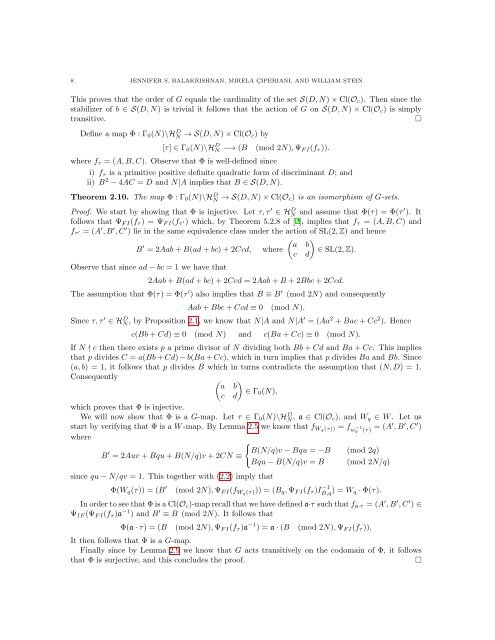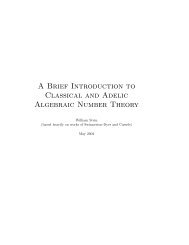p-ADIC HEIGHTS OF HEEGNER POINTS AND ANTICYCLOTOMIC ...
p-ADIC HEIGHTS OF HEEGNER POINTS AND ANTICYCLOTOMIC ...
p-ADIC HEIGHTS OF HEEGNER POINTS AND ANTICYCLOTOMIC ...
You also want an ePaper? Increase the reach of your titles
YUMPU automatically turns print PDFs into web optimized ePapers that Google loves.
8 JENNIFER S. BALAKRISHNAN, MIRELA ÇIPERIANI, <strong>AND</strong> WILLIAM STEIN<br />
This proves that the order of G equals the cardinality of the set S(D, N) × Cl(Oc). Then since the<br />
stabilizer of b ∈ S(D, N) is trivial it follows that the action of G on S(D, N) × Cl(Oc) is simply<br />
transitive. <br />
Define a map Φ : Γ0(N)\H D N → S(D, N) × Cl(Oc) by<br />
[τ] ∈ Γ0(N)\H D N −→ (B (mod 2N), ΨF I(fτ )).<br />
where fτ = (A, B, C). Observe that Φ is well-defined since<br />
i) fτ is a primitive positive definite quadratic form of discriminant D; and<br />
ii) B 2 − 4AC = D and N|A implies that B ∈ S(D, N).<br />
Theorem 2.10. The map Φ : Γ0(N)\H D N → S(D, N) × Cl(Oc) is an isomorphism of G-sets.<br />
Proof. We start by showing that Φ is injective. Let τ, τ ′ ∈ H D N and assume that Φ(τ) = Φ(τ ′ ). It<br />
follows that ΨF I(fτ ) = ΨF I(fτ ′) which, by Theorem 5.2.8 of [2], implies that fτ = (A, B, C) and<br />
fτ ′ = (A′ , B ′ , C ′ ) lie in the same equivalence class under the action of SL(2, Z) and hence<br />
B ′ = 2Aab + B(ad + bc) + 2Ccd, where<br />
Observe that since ad − bc = 1 we have that<br />
<br />
a b<br />
c d<br />
∈ SL(2, Z).<br />
2Aab + B(ad + bc) + 2Ccd = 2Aab + B + 2Bbc + 2Ccd.<br />
The assumption that Φ(τ) = Φ(τ ′ ) also implies that B ≡ B ′ (mod 2N) and consequently<br />
Aab + Bbc + Ccd ≡ 0 (mod N).<br />
Since τ, τ ′ ∈ H D N , by Proposition 2.1, we know that N|A and N|A′ = (Aa 2 + Bac + Cc 2 ). Hence<br />
c(Bb + Cd) ≡ 0 (mod N) and c(Ba + Cc) ≡ 0 (mod N).<br />
If N ∤ c then there exists p a prime divisor of N dividing both Bb + Cd and Ba + Cc. This implies<br />
that p divides C = a(Bb + Cd) − b(Ba + Cc), which in turn implies that p divides Ba and Bb. Since<br />
(a, b) = 1, it follows that p divides B which in turns contradicts the assumption that (N, D) = 1.<br />
Consequently<br />
which proves that Φ is injective.<br />
<br />
a<br />
c<br />
<br />
b<br />
∈ Γ0(N),<br />
d<br />
We will now show that Φ is a G-map. Let τ ∈ Γ0(N)\HD N , a ∈ Cl(Oc), and Wq ∈ W . Let us<br />
start by verifying that Φ is a W -map. By Lemma 2.5 we know that f Wq(τ)) = f w −1<br />
q (τ) = (A′ , B ′ , C ′ )<br />
where<br />
B ′ = 2Auv + Bqu + B(N/q)v + 2CN ≡<br />
since qu − N/qv = 1. This together with (2.2) imply that<br />
Φ(Wq(τ)) = (B ′<br />
<br />
B(N/q)v − Bqu = −B (mod 2q)<br />
Bqu − B(N/q)v = B (mod 2N/q)<br />
(mod 2N), ΨF I(f Wq(τ))) = (Bq, ΨF I(fτ )I −1<br />
B,q ) = Wq · Φ(τ).<br />
In order to see that Φ is a Cl(Oc)-map recall that we have defined a·τ such that fa·τ = (A ′ , B ′ , C ′ ) ∈<br />
ΨIF (ΨF I(fτ )a −1 ) and B ′ ≡ B (mod 2N). It follows that<br />
Φ(a · τ) = (B (mod 2N), ΨF I(fτ )a −1 ) = a · (B (mod 2N), ΨF I(fτ )).<br />
It then follows that Φ is a G-map.<br />
Finally since by Lemma 2.9 we know that G acts transitively on the codomain of Φ, it follows<br />
that Φ is surjective, and this concludes the proof.
















